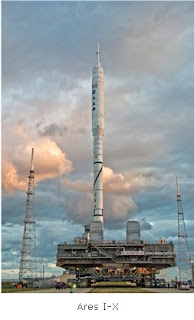Ares I-X was the first-stage prototype and design concept demonstrator of Ares I, a launch system for human spaceflight developed by the National Aeronautics and Space Administration (NASA).
Ares I-X was successfully launched on October 28, 2009. The project cost was $445 million.
The Ares I-X vehicle consisted of a functional four-segment solid rocket booster (SRB) stage, a fifth segment mass simulator, an upper-stage simulator (USS), which was similar in shape and heavier than the actual upper stage, as well as a simulated Orion crew module (CM) and launch abort system (LAS).
Since the actual upper-stage hardware could not be produced in time for the flight test, the upper-stage mass simulator allowed the booster to fly approximately the same trajectory through the first stage of flight. The USS and the CM/LAS mass simulators launched by the Ares I-X were not recovered and fell into the Atlantic Ocean. The first stage, including the fifth segment mass simulator, was recovered to retrieve flight data recorders and reusable equipment.
The Ares I-X vehicle used in the test flight was similar in shape, mass, and size to the planned configuration of later Ares I vehicles, but had largely dissimilar internal hardware, consisting of only one powered stage.
Ares I vehicles were intended to launch Orion crew exploration vehicles. Along with the Ares V launch system and the Altair lunar lander, Ares I and Orion were part of NASA's Constellation program, which was developing spacecraft for U.S. human spaceflight after the Space Shuttle retirement.
More information: Space Center
Ares I-X was the only test flight of a launch vehicle like the Ares I. The test flight objectives included:
-Demonstrating control of a dynamically similar vehicle using control algorithms similar to those used for Ares I.
-Performing an in-flight separation/staging event between an Ares I-similar First Stage and a representative Upper Stage.
-Demonstrating assembly and recovery of an Ares I-like First Stage at Kennedy Space Center (KSC).
-Demonstrating First Stage separation sequencing, and measuring First Stage atmospheric entry dynamics, and parachute performance.
-Characterizing the magnitude of integrated vehicle roll torque throughout First Stage flight.
The flight also had several secondary objectives, including:
-Quantifying the effectiveness of the first-stage booster deceleration motors.
-Characterizing induced environments and loads on the vehicle during ascent.
-Demonstrating a procedure for determining the vehicle's position to orient the flight control system.
-Characterize induced loads on the Flight Test Vehicle while on the launch pad.
-Assess potential Ares I access locations in the VAB and on the Pad.
-Assess First Stage electrical umbilical performance.
More information: NASA
The Ares I-X flight profile closely approximated the flight conditions that the Ares I would expect to experience through Mach 4.5, at an altitude of about 39,600 m and through a maximum dynamic pressure, Max Q, of approximately 38 kPa.
The Ares I-X flight profile resembled the uncrewed Saturn I flights of the 1960s, which tested the Saturn propulsion concept.
By flying the vehicle through first-stage separation, the test flight also verified the performance and dynamics of the Ares I solid rocket booster in a single stick arrangement, which is different from the solid rocket booster's then-current double-booster configuration alongside the external tank on the space shuttle.
Ares I-X had been scheduled for launch on October 27, 2009, the 48th anniversary of the first Saturn I launch. The launch attempt was delayed due to weather plus other last-minute concerns.
The ground crew experienced difficulty removing a protective cover from an important nose-mounted five-port sensor package.
A private watercraft had blundered into the restricted downrange safety zone and had to be chased away. Launching through the day's high cirrus clouds could have caused triboelectrification, potentially interfering with range safety communication and hampering the RSO's ability to issue the self-destruction command. Launch Director Ed Mango repeatedly delayed resumption of the countdown from the planned hold point at T-00:04:00.
Ultimately, constraints of the 4-hour launch window, coupled with high clouds and other last-minute concerns, caused the mission to be scrubbed for the day at 15:20 UTC on October 27, 2009. Launch was rescheduled for a four-hour window opening at 12:00 UTC on October 28, 2009.
Ares I-X launched on October 28, 2009 at 11:30 EDT (15:30 UTC) from Kennedy Space Center LC-39B, successfully completing a brief test flight. The vehicle's first stage ignited at T-0 seconds and Ares I-X lifted off from Launch Complex 39B.
The first stage separated from the upper-stage simulator and parachuted into the Atlantic Ocean roughly 240 km downrange of the launch site. The maximum altitude of the rocket was not immediately known, but had been expected to be 45 km.
The launch accomplished all primary test objectives, and many lessons were learned in preparing and launching a new vehicle from Kennedy Space Center.
More information: Space
you're not really flying that rocket.
You're just sort of hanging on.
Michael P. Anderson

No comments:
Post a Comment